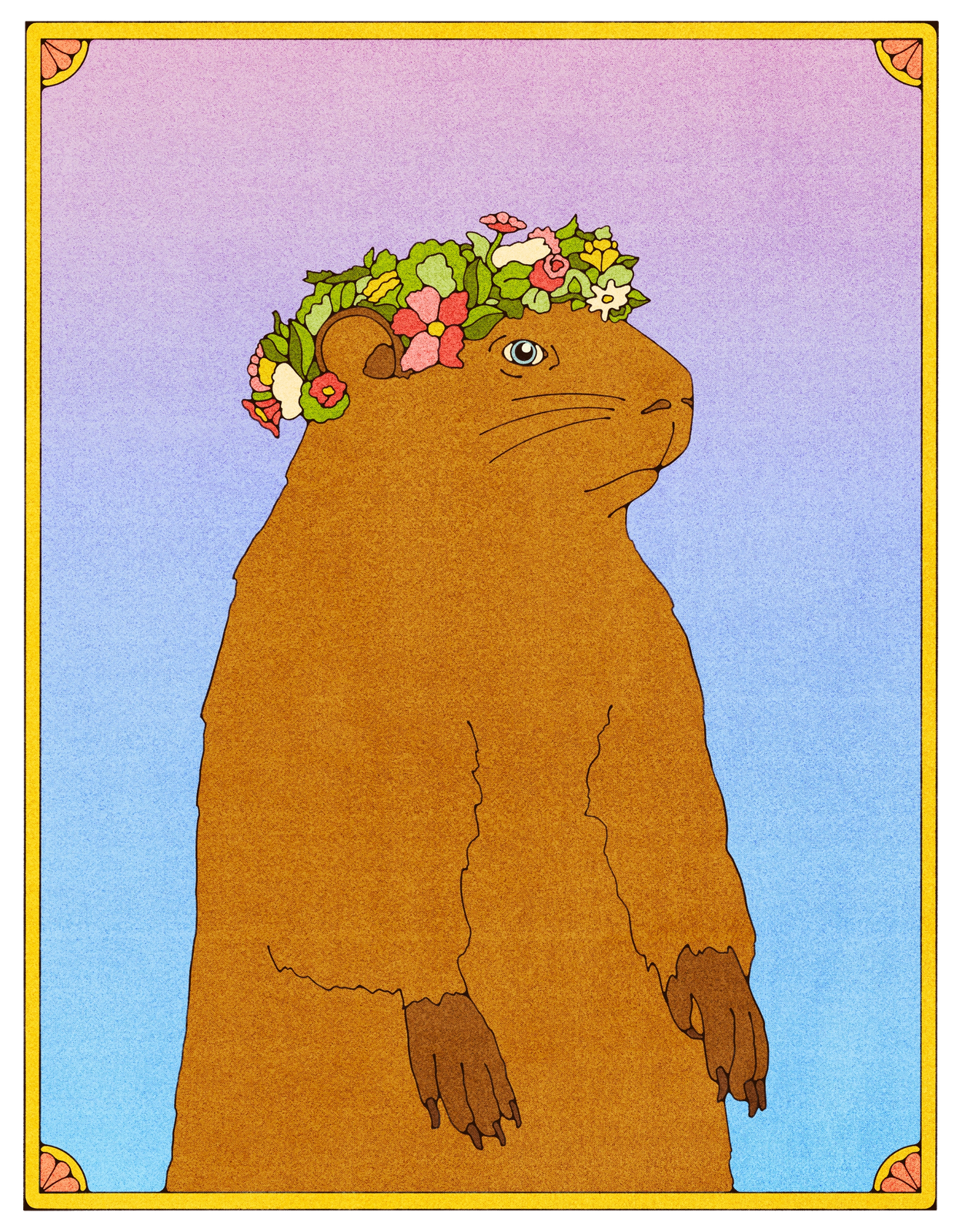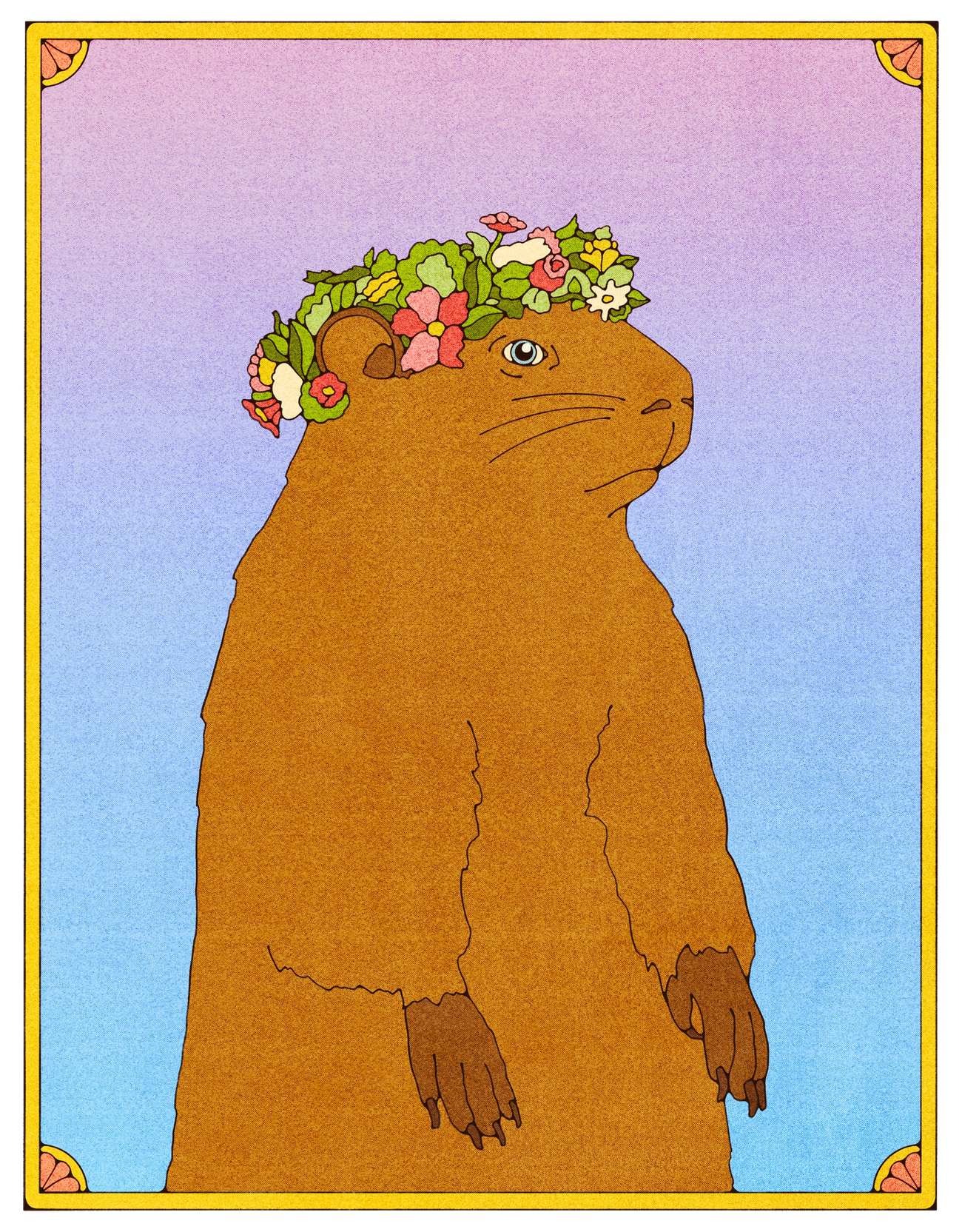Groundhog Day’s Christian—and Pre-Christian—Roots
It’s not just a strange American holiday, or the inspiration for a great movie.




Some French friends of mine made the Tocquevillian observation that Americans have so many quirky national holidays, without ever getting the day off for them. (This practice is almost a complete inversion of European countries, where schools and businesses routinely close for Christian holy days, even though most Europeans are nonpracticing.) Groundhog Day seems like just such an “only in America” holiday: our Puritan heritage brooking no notion of a day off for something so frivolous, but good at least for friendly small talk with coworkers or one’s dentist. It garners at least a lighthearted annual news segment. Indeed, this is the premise of the film Groundhog Day, when a news crew led by a producer named Rita (played by Andie MacDowell) heads to Punxsutawney, Pennsylvania, to cover the local festivities surrounding the groundhog’s emergence. “These people are great, some of them have been partying all night long. They sing songs till they get too cold, and then they go sit by the fire and they get warm, and then they come back and they sing some more!” she effuses about the town’s residents to Bill Murray’s nonplussed weatherman, Phil Connor. “Yeah,” he responds, “they’re hicks, Rita.”
Just as the groundhog cyclically emerges, returning to its den if it sees its shadow, thus heralding six more weeks of winter, the Phil of Groundhog Day confronts his own shadows through the apparently endless repetition of the same winter day. He must make some personal changes for the better before he can fully embrace the fate of a “long and lustrous winter” among the people with whom he finds himself, no longer contemptuously regarding them as backward simpletons. While much has been written about the Buddhist themes in the Harold Ramis classic, fewer people are probably aware of the ancient roots of the holiday that forms the film’s thematic backdrop.
Yes, Groundhog Day is a Christmas movie. Kind of.
On its surface, Groundhog Day seems like a quaint mid-Atlantic American folk custom, a subject that everyone in the country inexplicably must learn about in elementary school, like the song “Polly Wolly Doodle” or the life of Helen Keller. However, like Saint Patrick’s Day, Halloween, or Mardi Gras, Groundhog Day has its roots in European Christian customs, themselves likely grafted onto pre-Christian rituals, and duly assimilated to become a weird American holiday that occurs in an apparent temporal vacuum.
Feb. 2 marks 40 days after Christmas, and early Christians observed this day as the “Purification of the Blessed Virgin Mary.” It was a holy day recognizing events in the New Testament surrounding Christ’s first appearance in the Temple in Jerusalem, as an infant accompanying his mother for her ritual purification 40 days after giving birth, in accordance with the prescription found in Leviticus. Today called the “Presentation of the Lord” in the Roman Catholic liturgical calendar, the religious festival took on elements of different folk customs throughout Europe over the centuries to become a holiday known as Candlemas in English, when the faithful have traditionally brought candles to church to have them blessed by a priest. Historically, it was also when Christmas decorations came down.
On its surface, Groundhog Day seems like a quaint mid-Atlantic American folk custom, a subject that everyone in the country inexplicably must learn about in elementary school, like the song ‘Polly Wolly Doodle’ or the life of Helen Keller.
As is the case with Halloween and Christmas, Christian belief and preexisting folk customs appear to have gradually fused in popular observances of Candlemas. In some cases, those customs are quite old. In Ancient Rome, Feb. 15 was the feast of Lupercalia, a fertility festival, regarded today by some as a precursor to Valentine’s Day given that it included some raunchier erotic elements. However, Lupercalia was more broadly a winter festival of civic purification, and appears to be a more direct antecedent of Candlemas. There were torchlight processions instead of candles, and the name of the month of February actually comes from the Latin “februare,” meaning “to purify,” and Lupercalia was called dies februatus, “Purified Day.” Lupercalia continued into the fifth century CE, when some scholars think that Pope Gelasius put an end to it by instituting the Church-sanctioned holiday of the Purification of the Blessed Virgin Mary around the same time; before they settled on Dec. 25, early Christians celebrated Christmas on Jan. 6, which meant Feb. 14 fell 40 days after—right around Lupercalia.
The tradition of blessing candles is commonly associated with the motifs of fire and light in the scripture readings read at Mass on Candlemas (an abbreviation of Candle Mass, just as Christmas is an abbreviation of Christ’s Mass). The first passage read is from the prophet Micah, comparing the Lord of hosts to “a refiner’s fire,” and another is the account in the book of Luke of Mary and Christ in the Temple, 40 days after his birth, which refers to Christ as “a light for revelation to the Gentiles.”
Other vestigial pre-Christian customs are thought to remain in European Candlemas traditions. In France, it’s customary to serve crepes for dinner, a practice some hypothesize is associated with cakes eaten on Lupercalia, or even more primally, with the circular shape of the sun itself. The day is also accompanied by a superstitious hope for clear skies, indicating spring is on its way, instead of 40 days of rain showers that are presaged by rain. Candlemas as an augur of continued winter weather exists elsewhere in Europe and even the U.S.: In Ireland, there’s apparently a legend about a magical hag who controls the sun, and in the U.K. and early New England, a genre of rhymes and traditions about the forecasting powers of Candlemas were widespread.
Like many folk customs, it is difficult to identify a single reason for the thematic consistency of Candlemas practices across cultures. As Christopher Hill put it in his book Holidays and Holy Nights: Celebrating the Twelve Seasonal Festivals of the Christian Year, “they just seem to fit, evocatively, tantalizingly, with the sense of the season.”
So what of Punxsutawney Phil? How do we get from the Palatine Hill to Gobbler’s Knob? Quite simply, Groundhog Day is the Americanized German Candlemas tradition of looking to a hedgehog or badger to forecast the length of winter based on whether or not it sees its shadow. The U.S. isn’t a native habitat for hedgehogs, which is why aside from Sonic, we don’t hear much about them here. By contrast, the American landscape is positively alive with groundhogs (also known as woodchucks). So German immigrants to Pennsylvania made the switch, with the first recorded Groundhog Day occurring in 1886.
However secular the holiday has become, the silliness of an entire country turning its lonely eyes to the activities of a Pennsylvania-based rodent would seem to gesture toward an underlying, deeply human truth: the eternal need to look for light in darkness, and to mark the rhythmic turning of the seasons. “When Chekhov saw the long winter,” Phil Connor says near the end of Groundhog Day, “he saw a winter bleak and dark and bereft of hope. Yet we know that winter is just another step in the cycle of life.” The folly of Groundhog Day, coming in the midst of the dark stillness of winter and over a month after the bright hustle of the holidays, serves as an infinitesimal loosening of the national pressure valve, a brief, absurd instant of civic unity, and a promise of warmth and light to come.
This story is part of a series Tablet is publishing to promote religious literacy across different religious communities, supported by a grant from the Arthur Vining Davis Foundations.
Maggie Phillips is a freelance writer and former Tablet Journalism Fellow.